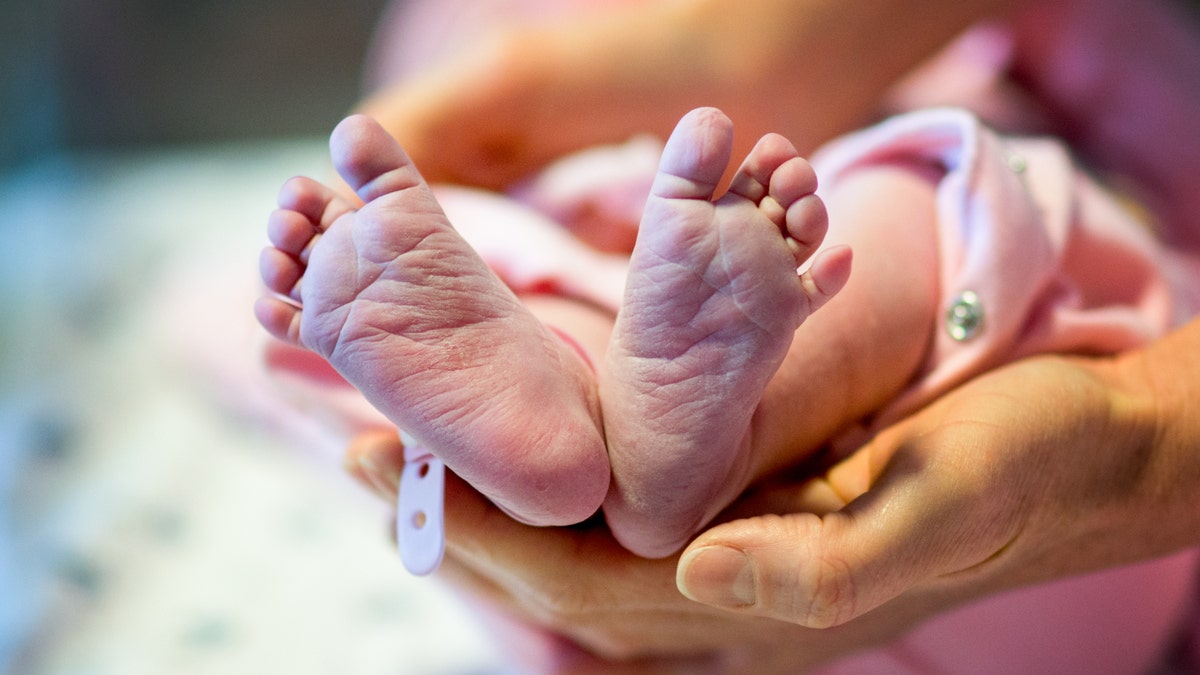
A newborn baby feet and hands of mother holding them tenderly (iStock)
- Women who get surgery to treat precancerous abnormalities on their cervix are more likely to have premature or low-birth weight babies than women who don't have these procedures, a recent study suggests.
Researchers focused on women with a common condition known as cervical dysplasia, abnormal tissue growth that is typically caused by the human papillomavirus (HPV). Milder cases of dysplasia may go away on their own, but doctors often surgically remove abnormal tissue in more severe cases to help prevent the condition from progressing to full-blown cervical cancer.
"Women who have already had the surgery to remove pre-cancerous lesions may want to wait a while to get pregnant, as we found the risk of pre-term birth increased even more if women gave birth within a year of their surgery," said study co-author Allison Naleway, of the Kaiser Permanente Center for Health Research in Portland, Oregon.
In the study, researchers examined data on pregnancy outcomes for 4,307 women who didn't have cervical procedures and compared them to 322 women who had surgery to remove precancerous tissue and another 847 women who had cervical biopsies to investigate abnormalities.
Women who had surgeries that cut out at least one centimeter of tissue were more than twice as likely to have preterm births or underweight babies as women who didn't have any cervical procedures, the study found.
And when women gave birth within one year of cervical surgery, their odds of these complications more than tripled.
Compared to women who didn't have surgery, those who did were more likely to be smokers, overweight or obese and first-time mothers.
Researchers looked at several common surgical methods for removing or destroying precancerous tissue, including excising cells with a scalpel or destroying tissue with a laser, using a thin wire loop to burn tissue with an electrical current or using a device that freezes tissue.
About 5 percent of women who had ablation procedures, typically using the wire loop, had preemies, compared with about 10 percent of women who had less than 1.6 centimeters of tissue excised with scalpels. When women had 1.6 centimeters of tissue or more cut out, 28 percent of them had preterm babies.
By way of comparison, 7 percent of women in the study who didn't have cervical procedures had preterm babies, as did 8 percent of women who had cervical biopsies.
Women who had excision procedures cutting out at least 1 centimeter of tissue were 2.2 times more likely to have low-birthweight babies as women who had no cervical surgery or only biopsies, researchers report in PLoS ONE.
Miscarriages and stillbirths were more likely among women who had ablations, however. About 25 percent of women who had ablations experienced pregnancy loss, compared with 19 percent of women who had excision procedures and 18 percent of women who didn't have cervical surgery or biopsy.
Cesarean deliveries were also more likely among women who had cervical surgeries, but the increased risk wasn't big enough to rule out the possibility that it was due to chance.
One limitation of the study is that researchers lacked data on excision thickness for some women and also didn't have information on a variety of factors that can influence pregnancy outcomes like women's income and education levels, marital status and type of insurance.
GlaxoSmithKline, which makes one of two HPV vaccines approved in the U.S., paid for the research and three of the authors were employees of the company at the time. A fourth author disclosed having received consulting fees from both GSK and Merck, which manufactures the other U.S.-approved HPV vaccine.
The results suggest that the actual treatment of cervical dysplasia, rather than the condition itself, is a relevant factor in increasing the risk of pregnancy complications, said Dr. Christina Chu, a gynecologic oncology researcher at Fox Chase Cancer Center in Philadelphia who wasn't involved in the study.
"The best thing that women can do is to protect themselves against HPV infection, which is the greatest risk factor for developing cervical dysplasia," Chu added by email. "Girls and young women should get the HPV vaccine."
When women are treated for this condition, waiting to have a baby may make sense.
"It does appear that the risks may be less for women who deliver more than one year after excision, so if excision is necessary, women may consider delaying pregnancy to allow the cervix to heal fully," Chu said.
